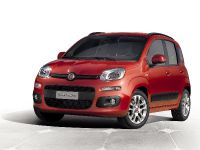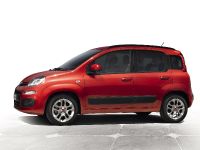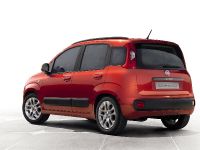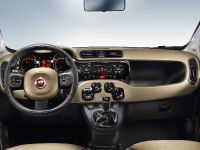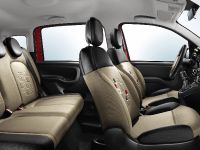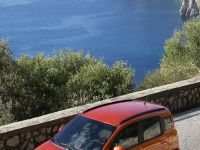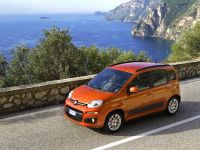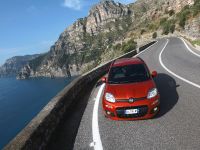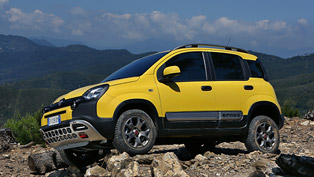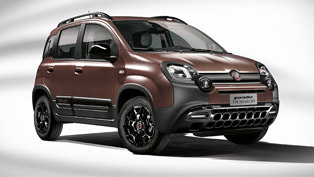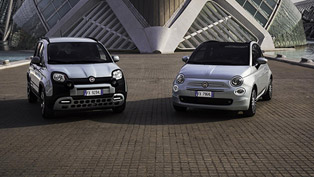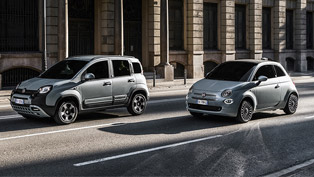2012 New Fiat Panda
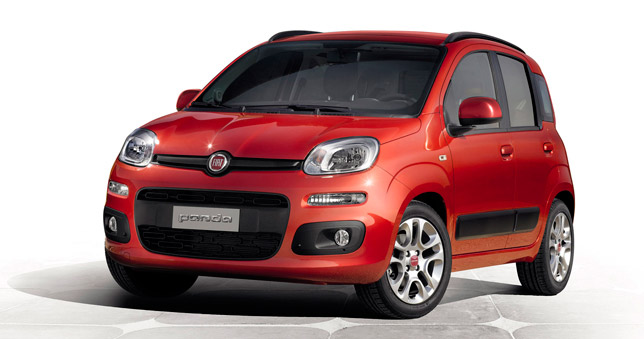 The new 2012 Fiat Panda is a continuation of an invention has its 31-year successful history. Now the third generation of the Panda model springs forth from this heritage. It offers more quality in terms of space, comfort, functionality, technology and safety features. In addition it combines the best features of the first- and second-generation cars. The car will definitely bring satisfaction to customers who want to combine the practical handling of a city car with the space and comfort of a five-door compact car. All this is further improved by the modern and harmonious appearance of the Panda.
The new 2012 Fiat Panda is a continuation of an invention has its 31-year successful history. Now the third generation of the Panda model springs forth from this heritage. It offers more quality in terms of space, comfort, functionality, technology and safety features. In addition it combines the best features of the first- and second-generation cars. The car will definitely bring satisfaction to customers who want to combine the practical handling of a city car with the space and comfort of a five-door compact car. All this is further improved by the modern and harmonious appearance of the Panda.
Now the third generation Panda has enhanced each of its elements both functionally and with attention to every detail. The result is of great overall harmony, due to applying signs consistent with one another that increase its usability and pleasing design values. First of all, the new car makes maximum use of the interior space, rationalising the dimensions. Nevertheless the car continues to be a very compact one but with slight grow with a few centimetres. This will unquestioningly ensure the attainment of the highest standards of safety and improve the generous level of passenger room.
We are speaking here about a length of 365 centimetres, a width of 164 and a height of 155, and with five doors. In this way the new Panda can comfortably accommodate up to five people. Moreover it has one of the most spacious boots in its segment: 225 litres which become 260 with the sliding rear seat in the fully forward position up to the point of reaching 870 litres with the backrest of the rear seats folded down. The new Fiat Panda conveys freshness and appeal in addition to a strong "Italian style" that makes it instantly recognisable from the very first glance: the slightly convex bonnet joins with the elegant horizontal grille and the new front headlamps with are made this time with rounded shape. Additionally to the interior has been added few graphic patterns which are decorating the door panels and roof of the car.
The Fiat Panda offers maximum freedom of use with its roomy, functional and comfortable passenger compartment that is in no way inferior to that of cars of a higher class. Besides, flexibility has always been one of the model's strong points, as the new dashboard, various seat configurations and large number of storage compartments. First of all, the new dashboard is designed as a practical multipurpose shell containing a roomy storage "pocket". Additionally there is a classic glovebox stored in the lower part of the dashboard. To be more precise the dashboard is wrapped up in a colourful frame, radio and main controls. Furthermore is something new around the seats, which make the model more flexible. Firstly, the driver's seat is available with height adjustment, whereas the front passenger seat can be fitted with a backrest that folds down to form a table. Next, the rear seat is available in the standard 2-seater version with fold-down split backrest or, upon request, in the configurations: 2 seats sliding longitudinally with fold-down 50/50 split backrest, 3 seats with fold-down backrest and 3 seats with fold-down 60/40 split backrest.
The new Panda includes innovative features that simplify and improve life on-board accessible to everyone. Specifically, the vehicle offers sophisticated technological solutions: the "Low Speed Collision Mitigation" braking system and the "Blue&Me TomTom 2 LIVE" navigation system. Furthermore it also includes features such as Start&Stop, Gear Shift Indicator (GSI), ecoDrive and ECO mode of the TwinAir Turbo engine.
What has to be highlighted in this new Panda are the brand new two-cylinder engines equipped with the Start&Stop system as standard: 85 HP 0.9 TwinAir Turbo, named "International Engine of the Year 2011", and the brand new 65 HP 0.9 aspirated TwinAir, adopted for the first time. The renewed 69 HP 1.2 Fire petrol engine and the 75 HP 1.3 Multijet II, also with Start&Stop supplied standard, complete the range of engines.
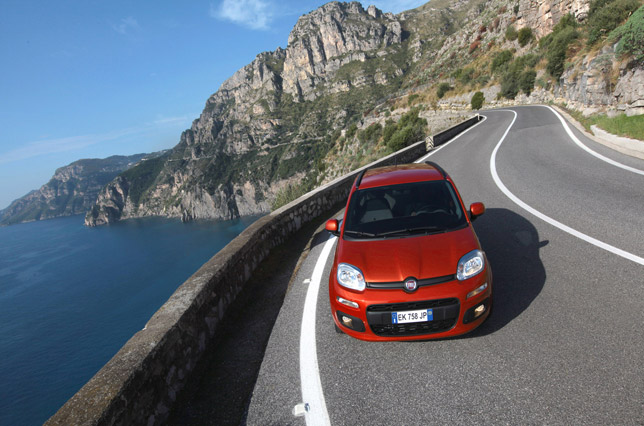
To go further into details, the 85 HP 0.9 TwinAir Turbo is the first of a new family of two-cylinder engines developed by Fiat Powertrain This 0.9 TwinAir Turbo engine develops 85 HP (63 kW) at 5500 rpm of full power and a torque of 145 Nm/107 lb-fr at 1900 rpm (constant up to 3000 rpm). Moreover, if you prefer to be "eco" friendy and lower the fuel consumption, you can press the ECO key on the dashboard to limit torque to 100 Nm/74 lb-ft at 2000 rpm. This engine records 4.2 litres/100 km and CO2 emission equal to 99 g/km in the combined cycle. No surprise it was the "International Engine of the Year 2011". Next is the 65 HP 0.9 aspirated TwinAir. Interesting here is that this is Fiats world debut in the "aspirated" version of the TwinAir engine that delivers maximum power of 65 HP (48 kW) at 6250 rpm and a torque of 88 Nm/65 lb-ft at 3500 rpm. All with a reduction in fuel consumption and CO2 emissions - the values recorded in the combined cycle are 4.2 l/100 km and 99 g/km, respectively. What is more important is that the performance is comparable to engines of the same power. The thid version is 69 HP 1.2 Fire EVO II, which is the latest evolution of the FIRE family that boasts over 10 million units produced. Thanks to the continuous updates and its flexible architecture, this family of engines remains a point of reference in the category as use of the continuously variable valve timing unit shows, able as it is to optimize valve timing (opening and closing) at all engine speeds. Hence not only the fuel consumption and CO2 emissions are reduced (5.2 litres/100 km and 120 g/km, respectively), but also the performance is increased to ensure torque availability at low rpm (102 Nm/75 lb-ft at 3000 g/min) and power at high rpm (69 HP/51 kW at 5500 g/min). At last comes the 75 HP 1.3 Multijet II, which has been made with a respect to the environment! The all-new Panda offers the 1.3 MultiJet II (Euro5) with DPF standard will also deliver a driving satisfaction with its maximum output of 75 HP/ 55 kW at 4000 rpm and a torque of 190 Nm/140 lb-ft at just 1500 rpm.
The new model of the car will be available with front-wheel drive. Next, the Panda 4x4 will make a debut offering 3 trim levels - Pop, Easy and Lounge - 10 body colours, 9 interior environments, 2 hub caps and 2 14" and 15" alloy wheels. Of course, the new contents will include the "Blue&Me TomTom LIVE". The innovative optional LSCM (Low Speed Collision Mitigation) braking system will become also available. In details, this system can detect an obstacle present nearby and automatically brake at speeds slower than 30 km/h.
Fiat has though for the safety and security of the driver and the passengers too. To guarantee them, the new Panda combines a body designed according to the most modern criteria with active and passive safety content that ensures its optimum performance. The safety performance was designed by the designers and the Fiat Safety Centre after examining all possible types of collisions: front and side impacts, roll-over, pile-up and collisions with pedestrians. Various speeds at which impact may occur were also taken into consideration as well as different types of obstacles and different types of occupants with greatly varying physical characteristics. And to guarantee the protection of the occupants, the new Panda offers 4 airbags standar, ABS complete with B.A.S. (Brake Assist System), front seat belts with pretensioner and load limiter. Depending on the markets and versions, the ESC (Electronic Stability Control) complete with Hill Holder system. At last, the new "Low Speed Collision Mitigation" system is an innovative active safety feature, which is capable of recognising obstacles in front of the car and of braking automatically when the driver fails to avoid the collision. The control unit of this LSCM system is designed to activate automatic braking, following a request by the laser sensor, in addition to being designed to request a reduction in the torque from the engine control unit if the accelerator pedal has not been released. The aim of Fiat is with the help of this LSCM system to guarantee maximum safety in all conditions of use!
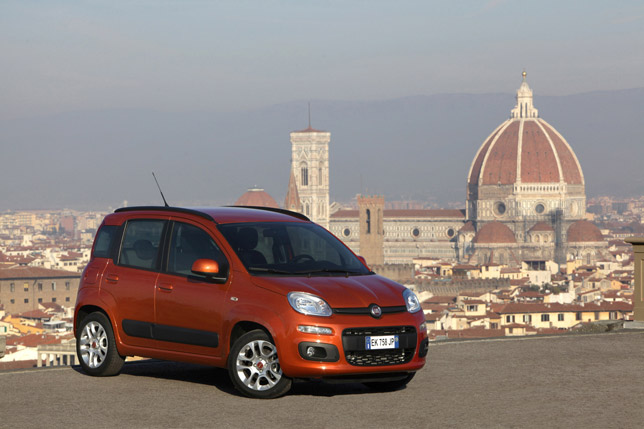
|
Pop / Easy / Lounge |
||||
|
1.2 8v 69 HP |
1.3 MultiJet 75 HP Stop&Start |
0.9 85 HP TwinAir Stop&Start |
0.9 65 HP TwinAir Stop&Start
|
|
| ENGINE | ||||
| No. of cylinders and arrangement |
4L |
4L |
2L |
2L |
| Diameter x stroke (mm) |
70.8 x 78.9 |
69.6 x 82 |
80.5 x 86 |
83.5x88.0 |
| Displacement (cm3) |
1242 |
1248 |
875 |
964 |
| Compression ratio |
11.1 |
16.8 |
10 |
11.2 |
| Max EC power: kW (HP) at rpm |
51 (69) at 5500 rpm |
55 (75) at 4000 rpm |
63 (85) at 5500 rpm |
65 (48) at 6250 rpm |
| EC max. torque: Nm at rpm |
102 at 3000 rpm |
190 at 1500 rpm |
145 at 1900 rpm |
88 at 3500 rpm |
| Timing system (drive) |
Belt |
Chain |
Chain |
Chain |
| Power supply |
P |
DS |
P |
P |
| Ignition |
Controlled |
Through compression |
Controlled |
Controlled |
| TRANSMISSION | ||||
| Drive |
C514 MT |
C510 DS MT |
C514 MT |
C514 MT |
| Clutch |
Mechanical |
Hydraulically operated |
Hydraulically operated |
Mechanical |
| Transmission: 1st |
4.100 |
4.273 |
4.100 |
4.100 |
| 2nd |
2.158 |
2.238 |
2.158 |
2,158 |
| 3rd |
1.480 |
1.444 |
1.345 |
1.345 |
| 4th |
1.121 |
1.029 |
0.974 |
0.974 |
| 5th |
0.897 |
0.767 |
0.766 |
0.766 |
| 6th |
- |
- |
- |
- |
| Reverse |
3.818 |
3.909 |
3.818 |
3.818 |
| Final reduction ratio |
3.438 |
3.150 |
3.867 |
4.500 |
| STEERING SYSTEM | ||||
| Type |
Rack and pinion with electric power steering |
Rack and pinion with electric power steering |
Rack and pinion with electric power steering |
Rack and pinion with electric power steering |
| Turning circle (m) |
9.3 |
9.3 |
9.3 |
9.3 |
| BRAKES - D (disc) - T (drum) | ||||
| Front: mm |
D257X12 |
D257X22 self-ventilating |
D257X22 self-ventilating |
D257X12 |
| Rear: mm |
T203 |
T203 |
T203 |
T203 |
| SUSPENSION | ||||
| Front |
Independent wheels, McPherson type with lower crosswise wishbones secured to an auxiliary crossmember |
Independent wheels, McPherson type with lower crosswise wishbones secured to an auxiliary crossmember |
Independent wheels, McPherson type with lower crosswise wishbones secured to an auxiliary crossmember |
Independent wheels, McPherson type with lower crosswise wishbones secured to an auxiliary crossmember |
| Rear |
Interconnected wheels by means of torsion beam |
Interconnected wheels by means of torsion beam |
Interconnected wheels by means of torsion beam |
Interconnected wheels by means of torsion beam |
| DIMENSIONS | ||||
| Wheelbase (mm) |
2300 |
2300 |
2300 |
2300 |
| Front/rear track (mm) |
1409 |
1409 |
1409 |
1409 |
|
1407 |
1407 |
1407 |
1407 |
|
| Length / Width / Height (m) |
L: 3653 W: 1643/1882 (without/with mirrors) H: 1551 |
L: 3653 W: 1643/1882 (without/with mirrors) H: 1551 |
L: 3653 W: 1643/1882 (without/with mirrors) H: 1551 |
L: 3653 W: 1643/1882 (without/with mirrors) H: 1553
|
| VDA luggage capacity (litres)(standard - rear sliding seat forward - backrest folded down) |
225 – 260 - 870
|
225 – 260 - 870
|
225 – 260 - 870
|
225 – 260 - 870
|
| WHEELS | ||||
| Tyres |
175/65 R14 82T |
175/65 R14 82T |
175/65 R14 82T |
175/65 R14 82T |
| (*) = Optional |
185/55 R15 82T |
185/55 R15 82T |
185/55 R15 82T |
185/55 R15 82T |
| Space-saver wheel opt. 803 |
135/80 R14 84M |
135/80 R14 84M |
135/80 R14 84M |
135/80 R14 84M |
| ELECTRIC EQUIPMENT (12 V) | ||||
| Battery capacity (Ah) |
40 Ah |
63 Ah |
63 Ah |
63 Ah |
| Alternator: max. current (A) |
90A (heated / A/C) |
105A (heated) |
105A (heated) |
105A (heated) |
|
120A (A/C) |
120A (A/C) |
120A (A/C) |
||
| WEIGHT - CAPACITIES | ||||
| (TYPE-APPROVED WEIGHTS) | ||||
| Service weight DIN (kg) |
940 |
1035 |
975 |
Undergoing type-approval |
| Fuel tank capacity (litres) |
37 |
37 |
37 |
37 |
| Payload including driver |
500 (5 seat version) |
500 (5 seat version) |
500 (5 seat version) |
Undergoing type-approval |
|
480 (4 seat version) |
480 (4 seat version) |
480 (4 seat version) |
Undergoing type-approval |
|
| Max towing weight |
800 (braked) 400 (non-braked) |
900 (braked) 400 (non-braked) |
800 (braked) 400 (non-braked) |
Undergoing type-approval |
| PERFORMANCE | ||||
| Maximum speed (km/h) |
164 |
168 |
177 |
159 |
| Acceleration (sec.): 0 – 100 km/h |
14.2 |
12.8 |
11.2 |
15.7 |
| CONSUMPTION EEC (l/100km) | ||||
| According to Directive 1999/100/EC | ||||
| Urban, extra-urban, combined cycle |
6.7/4.3/5.2 |
4.7/3.5/3.9 |
5.0/3.8/4.2 (2) |
Undergoing type-approval |
| CO2 (g/km) |
120 |
104 |
99 |
99 |
1) Only for TwinAir with ECO button pressed:
| Max EC power: kW (HP) at rpm |
57 (77.5) at 5500 rpm |
|||
| EC max. torque: Nm at rpm |
100 at 2000 rpm |
2) MTA version:
| Urban, extra-urban, combined cycle |
4.8/3.7/4.1 |
|||
| CO2 (g/km) |
95 |
Source: FIAT
